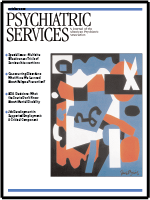Special Section on Relapse Prevention: Substance Abuse Relapse in a Ten-Year Prospective Follow-up of Clients With Mental and Substance Use Disorders
Abstract
OBJECTIVES: This study addressed the rate and predictors of substance abuse relapse among clients with severe mental illness who had attained full remission from substance abuse. METHODS: In a ten-year prospective follow-up study of clients with co-occurring severe mental and substance use disorders, 169 clients who had attained full remission, defined according to DSM-III-R as at least six months without evidence of abuse or dependence, were identified. The Kaplan-Meier survival curve was developed to show the pattern of relapse, and a discrete-time survival analysis was used to identify predictors of relapse. RESULTS: Approximately one-third of clients who were in full remission relapsed in the first year, and two-thirds relapsed over the full follow-up period. Predictors of relapse included male sex, less than a high school education, living independently, and lack of continued substance abuse treatment. CONCLUSIONS: After attaining full remission, clients with severe mental disorders continue to be at risk of substance abuse relapse for many years. Relapse prevention efforts should concentrate on helping clients to continue with substance abuse treatment as well as on developing housing programs that promote recovery.



